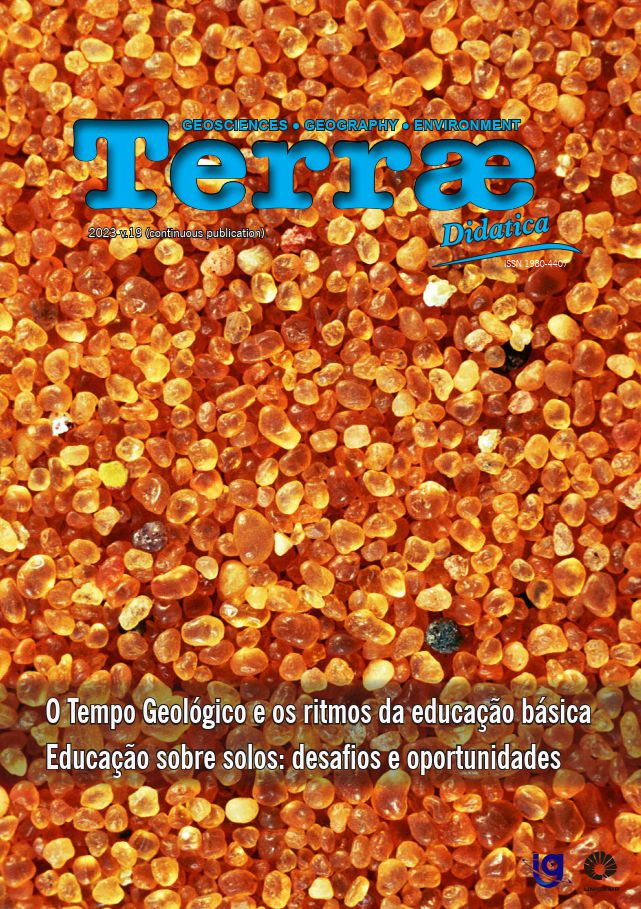Abstract
The study of Geoheritage encompasses the study of geosites, which involve the most varied geological aspects with scientific value of a region, including geomorphological, paleontological, speleological, archaeological, among others. The practices linked to the conservation of geoheritage are called geoconservation and their importance is justified by consolidating actions and policies that will allow the maintenance of the record of important aspects of the Earth's geological history. Let us think of the Teaching of Geosciences as an ally in the conservation of Geoheritage, because, through it, future generations are taught about the importance and conservation of geosites (geoheritage unit, a place of interest for preservation) and geoparks (cluster of several geosites). The teaching of Geosciences, focused on contents related to Geology and Life Sciences, presents similarities to the subjects of Natural Sciences and Biology in basic education, including the use of ICTs. Aiming to combine geoheritage teaching with information and communication technologies, we bring as an object of study the virtual map of paleontological and speleological geosites of Minas Gerais, developed from geosites cataloged by the Brazilian Commission of Geological and Paleontological Sites (SIGEP). The applicability and effectiveness of applying this virtual map to higher education students was tested. It is concluded that, although the public has knowledge about geodiversity and geoheritage, this map still has good applicability about geoheritage teaching and can, therefore, be a didactic tool that contributes to geoconservation.
References
Batista, L. N. (2015). A cartografia escolar no processo de ensino-aprendizagem: o hipermapa e sua utilização na educação ambiental, em Quevedos (RS). Santa Maria: Centro de Ciências Naturais e Exatas. 139p. (Dissert. Mestrado).
Belloni, M. L. (2022). O que é mídia-educação. Campinas: Autores Associados. 101p.
Borba, A. W. (2011). Geodiversidade e geopatrimônio como bases para estratégias de geoconservação: conceitos, abordagens, métodos de avaliação e aplicabilidade no contexto do Estado do Rio Grande do Sul. Pesquisas em Geociências, 38(1), 3-13. doi: 10.22456/1807-9806.23832.
Brilha, J. (2005). Património geológico e geoconservação: a conservação da natureza na sua vertente geológica. Braga: Palimage. 183 pp. URL: http://www.dct.uminho.pt/docentes/pdfs/jb_livro.pdf. Acesso 22.01.2023.
Brilha, J. (2016). Inventory and quantitative assessment of geosites and geodiversity sites: a review. Geoheritage, 8(2), 119-134. doi: 10.1007/s12371-014-0139-3.
Chaves, R. S., Moraes, S. S. de, & Lira-da-Silva, R. M. (2019). Definindo diretrizes para a elaboração de um produto educacional para o ensino de Tempo Geológico na educação básica brasileira. Indagatio Didactica, 11(2), 673-690. doi: 10.34624/id.v11i2.6535.
Costa, P. L., & Sanchez, E. A. M. (2016). Experimentação Investigativa e Ilustrativa: um estudo sobre a efetividade no ensino de Geociências. Terræ Didatica, 12(3), 220-230. doi: 10.20396/td.v12i3.8647899.
Dourado, I. F., Souza, K. L., Carbo, L., Mello, G. J., & Azevedo, L. F. (2014). Uso das TIC no ensino de ciências na educação básica: uma experiência didática. Revista de Ensino, Educação e Ciências Humanas, 15. doi: 10.17921/2447-8733.2014v15n0p.
Garcia, C. B., Imbernon, R. A. L., & Lacerda, R. A. V. (2014). Desenvolvimento de recursos didáticos para o ensino de Geociências para a Banca das Ciências e Experimentoteca da EACH/USP. Terræ Didatica, 10(3), 331-335. doi: 10.20396/td.v10i3.8637348.
Guimarães, T. O., Moura-Fé, M. M., & Almeida, R. R. (2022). Geopatrimônio: por quê? Para quê? Para quem? PerCursos, 23(52), 332-362. doi: 10.5965/1984724623522022332.
Kripka, R. M. L., Viali, L., & Lahm, R. A. (2014). Utilização dos recursos do Google EarthTM e do Google MapsTM no ensino de ciências. Revista Latinoamericana de Tecnologia Educativa, 13(2), 89-101. doi: 10.17398/1695288X.13.2.89.
Martinelli, M. (2011). Mapas da Geografia e Cartografia Temática. São Paulo: Contexto. 144p.
Moraes, R.; & Galiazzi, M. C. (2006). Análise textual discursiva: processo reconstrutivo de múltiplas faces. Ciência & Educação, 12(1), 117-128. doi: 10.1590/S1516-73132006000100009.
Oliveira, M. M. (2007). Como fazer pesquisa qualitativa. Petrópolis: Editora Vozes. 232p.
Sharples, C. (1993). A methodology for the identification of significant landforms and geological sites for geoconservation purposes. Forestry Comission, Tasmania. URL: https://eprints.utas.edu.au/11747/. Acesso 05.05.2023.
SIGEP Comissão Brasileira de Sítios Geológicos e Paleobiológicos. (2023). Comissão Brasileira de Sítios Geológicos e Paleobiológicos. SIGEP. URL: https://sigep.eco.br/. Acesso 05.05.2023.
Silva, J. F. D. A., & Aquino, C. M. S. de. (2018). Ações geoeducativas para divulgação e valorização da geodiversidade e do geopatrimônio. Geosaberes: Revista de Estudos Geoeducacionais, 9(17). doi: 10.26895/geosaberes.v9i17.617.
Zabala, A. A. (1998). Prática Educativa: como ensinar. Porto Alegre: Artmed. 224p.

This work is licensed under a Creative Commons Attribution 4.0 International License.
Copyright (c) 2023 Ricardo Almeida de Moura, Giovana Kelly Ribas, Evelyn Sanchez


